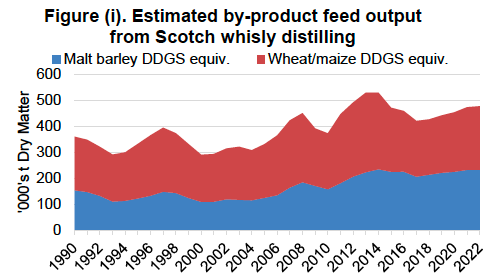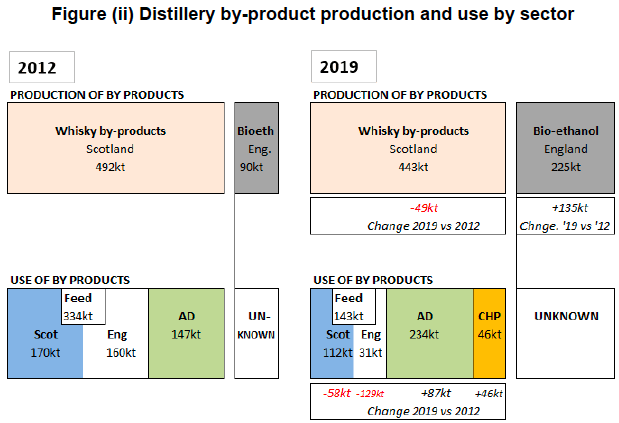Distillery by-products, livestock feed and bio-energy use: report
We commissioned this report in response to concerns by livestock farmers about the impact of anaerobic digestion and bio-energy on the availability of distillery by-product for use as livestock feed in Scotland.
Executive Summary
Summary
(i) Distillery by-products are an important feed for the livestock sector in Scotland. In recent years, livestock feed use has fallen due to a fall in whisky production and an increased use in bio-energy, which has in turn been driven by government carbon reduction targets and incentives. A rise in bio-ethanol by-products output in England has partly offset this on a UK wide basis. Distillery by-products had been a surplus product in Scotland and the livestock sector had benefitted from lower feed prices. This has changed due to falling supply and rising demand leading to an increase in the price of distillery by-products. Farmers have adapted by making better use of home grown forage and switching to alternative feeds. Forecasts of rising whisky production are expected to see rising distillery by-product output in the next few years.
Study objectives
(ii) This report was commissioned by Scottish Government in response to concerns by livestock farmers about the impact of anaerobic digestion and bio-energy on the availability of distillery by-product in Scotland. The study aims to investigate the parameters influencing the supply of these feeds to farmers and their reactions.
Distillery by-product output
(iii) Distillery by-product output mirrors changes in Scotch whisky production. The industry is estimated to have produced a record 531,000t DM of by-product in 2013. Output then fell 20% (109,000t DM) by 2017 to a low of 422,000t DM. Output has since started to rise and is expected to increase 13% (56,000t DM) between 2017 and 2022.

Source: SRUC
Production and use of distillery and brewery by-products in the UK and Scotland
(iv) SRUC working with the feed trade estimate that around 142,800t Dry Matter (DM) of distillery by-products from the whisky industry in Scotland will be used in UK animal feed in 2019. This represents a reduction of 57% on estimated UK feed use of 334,200t DM in 2012. Due to an increasing share of consumption occurring in Scotland, total use of distillery by-products in Scotland is expected to be 111,825t DM in 2019, down 36% from 2012 levels. Bio-energy use of distillery by-products is expected to have risen by 133,000t DM between 2012 and 2019; 87,000t DM in AD and 46,000t DM in CHP. In 2019 the quantity of distillery by-products used in animal feed in Scotland is estimated to represent for cattle (beef and dairy) around 8% of national concentrate feed requirement and 2% of total feed needs on an energy basis. By-products from breweries and maltings provide additional feed sources in Scotland equivalent to around 2% and 5% respectively of the quantity of by-product produced by the Scotch whisky distilling sector.

Source: SRUC
Bio-energy is now the dominant use for distillery by-products in Scotland
(v) Animal feed now comprises an estimated 32% of demand for distillery by-products in Scotland down from 68% in 2012. Bio-energy in contrast is now the dominant use having risen from 30% of distillery by-product use in 2012 to an estimated 63% share in 2019.
English ethanol distillery by-product production had offset declines in Scotland
(vi) Since 2012, UK bio-ethanol production from plants in the north of England had increased sharply leading to a greater overall UK supply of distillery by-products for feeds helping offset declines in Scotch whisky distillery by-product availability for feed. In 2018 a large ethanol plant was closed (presumed permanently) and another announced a period of extended closure from December 2018 due to poor profitability. This is likely to lead to an overall reduction in UK distillery by-product availability compared to the levels seen in the last SRUC study in 2012.
Scottish AD plants use feedstock estimated at 9% of Scottish cattle feed use; split equally between agricultural and distillery run AD plants
(vii) SRUC’s model of cattle feed demand and estimates of feedstock usage by agricultural and distillery AD plants and distillery CHP plants indicate that bio-energy now uses feedstock equivalent to around 9% of the total feed requirement of the Scottish cattle herd (beef and dairy). SRUC estimates suggest that both agriculture and distilling sectors now use a similar quantity of feedstock and so both may be having a similar impact on feed availability and markets.
Relative draff prices have risen sharply in the last two years, farmers are making better use of home grown feed
(viii) Price spreads indicate that fresh distillery by-products i.e. draff have become relatively more expensive since 2016 and have moved back to a comparable relative nutritional value. In response to rising feed costs, livestock farmers have taken steps to increase the value of home grown feeds. The most significant impact has been to improve the quality and feeding value of both grazed grass and grass silage.
Feed remains an important end use for distillery products
(ix) Feed remains an important end user for distillery products and farmers have responded to rising prices and lack of availability by placing greater value on the supplies available. The dairy sector is taking a greater share of what is available and through its year round feed requirement is well placed to ensure consistent off-take of moist distillery feeds. In the Highlands and Islands beef producers are becoming more pro-active in securing and storing supplies of draff and offer a valuable market for the expanding malt distilling sector where lack of scale and distance from alternative markets limit options. Equally, local farmers gain a valuable and cost effective feed supply in areas where high transport costs make bought in feed particularly expensive.
Contact
Email: Gordon.Jackson@gov.scot
There is a problem
Thanks for your feedback